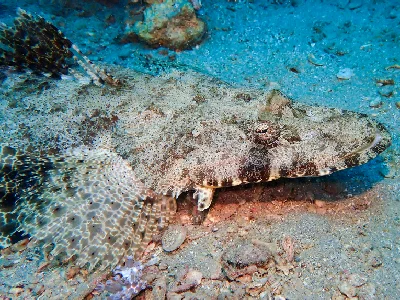Tentacled flathead
Papilloculiceps longiceps
🌊 Indian Ocean Crocodilefish (The tentacled flathead), scientifically known as Papilloculiceps longiceps, belongs to the family Platycephalidae, commonly referred to as flatheads. This marine ray-finned fish species is primarily found in the undefined, including the 🌊 Red Sea and the Mediterranean. It gained entry into these regions as a Lessepsian migrant through the Suez Canal (🇪🇬 Egypt). Interestingly, it is the sole species within the monotypic genus Papilloculiceps.
First described by the French zoologist Georges Cuvier in 1829, the tentacled flathead was initially identified as Platycephalus longiceps. Subsequently, the French zoologist Henri Émile Sauvage described a distinct species named Platycephalus grandidieri in 🇲🇬 Madagascar in 1873. In 1956, the American zoologist Henry Weed Fowler and the 🇮🇱 Israeli ichthyologist Heinz Steinitz proposed a new monotypic genus, Papilloculiceps, with Sauvage's Platycephalus grandidieri as its type species. However, Papilloculiceps grandidieri is now considered to be a junior synonym of Cuvier's Papilloculiceps longiceps. This genus falls within the Playtcephalidae family, classified under the suborder Platycephaloidei in the order Scorpaeniformes, according to the 5th edition of Fishes of the World.
The name Papilloculiceps is derived from the words "papilla," meaning "nipple," and "oculus," translating to "eye." This refers to the small flattened papilla on the upper surface of the eyeball that is inconspicuous in this species. The term "ceps," meaning "head," is suffixed to signify the head's similarity to that of a crocodile's.
Featuring an elongated body, the tentacled flathead possesses a depressed head with five prominent nuchal spines. The ridges on its preoperculum and operculum are smaller on the dorsal side compared to the ventral side. It exhibits a spine at the rear of the suborbital ridge that culminates in a small spine. Additionally, there are small spines on the preoperculum, a smooth supraorbital with a tiny terminal spine, one preocular spine, and two parietal spines. The upper surface of the eyes is notable for its papillae. This species boasts nine spines in the first dorsal fin, while the second dorsal fin and the anal fin each have eleven soft rays. The tentacled flathead can reach a maximum published total length of 70 cm (28 in), although 50 cm (20 in) is more commonly observed. Its body exhibits a mottled brownish or greenish color dorsally, while the ventral side appears whitish. The caudal fin typically exhibits three or four dark bands, and the other fins are marked with prominent, dark blotches.
The tentacled flathead is distributed in the undefined, spanning from northern KwaZulu-Natal (🇿🇦 South Africa) to 🇲🇬 Madagascar and the northern 🌊 Red Sea. A single record of this species was reported off the coast of 🇮🇱 Israel in the Mediterranean Sea in 1986. It can be found near coral reefs, inhabiting sand or rubble substrates at depths ranging from 1 to 15 m (3 ft 3 in and 49 ft 3 in).
Functioning as a well-camouflaged predator, the tentacled flathead primarily preys on fish and crustaceans, employing ambush tactics.
Comments
Please, sign in to leave comment
No Comments yet
Last Update: May 28, 2025

